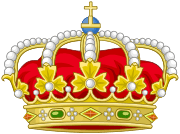Castle Alcázar of Segorbe

The Castle Alcázar of Segorbe was an alcázar and castle located in the hill of Sopeña in the town of Segorbe, in Valencian Community, Spain. Very little was what finally remain from the old Alcázar, this enormous complex that for over a thousand years was the residence of the most important lords, dukes and kings.[1]
Bernardo Espinalt, in 1784, in his Atlante Español, insists that the urban expansion of Segorbe was completely open outside the medieval Walls, which had led to the need to establish a new Walls that largely relied on the old layout, being the rest new construction. The new Walls had nine gates, which were to be those of Teruel, Argén, Sopeña, Cárrica, Castellnovo, Valencia, la Maza and Altura, gates that are well documented in contemporary and later writings. The last years of the century lead the decisive ruin of the millennial Alcázar.
Bishop Lorenzo Gómez de Haedo decides the construction of a new hospital and House of Mercy, and think of the Alcázar for the extraction of materials with which to carry out the work. The demolition began in March 1784. Finally it reach the total destruction of the main architectural ensemble of Segorbe, which had sheltered the city for centuries. After downing only it remained standing a few remains of the walls closing the enclosure on the southern slopes of the rise, while the above constructions were completely destroyed. The Bishop Aguilar seems finally aware of the huge irreparable loss this enclave, although it is late. In fact for years that it was not used as a stately home and a strategic summit it did not use since the beginning of the century. In any case, its facilities, at least some, had to remain in good conditions, as annually was the setting for the votive festivals celebrated by the Cathedral for Our Lady of La Leche. This Virgin was the owner of the Chapel of the Alcázar from the 16th century and its image remained in the Castle until the demolition. Currently, there are some fortifications built to mark the Carlist Wars.
History
The Arabs who first built a real fortress with alcázar, by the family Baraní of the Sinhaya confederacy, reaching great importance for centuries. It was ceded to James I of Aragon by Muslim king of Valencia Zeit Abu Zeit in 1229, when he became a Christian and it declared ally and vassal, becoming governor general of Valencia on his behalf.
It came to be a refugee the king himself when was dispossessed by Dynamil Zayyan until James I it conquered in 1245 by taking effective possession of it and putting to Abu Zeit in command of one of his armies to help in taking Valencia.
It know that the peak of the Christian castle was in the 14th and 15th centuries, culminating in the holding of General Courts by King Martin of Aragon, who had fixed his residence in the city.
Among the lords of Segorbe stands Doña Maria de Luna, wife of King Martin, and therefore Queen of Aragon, with that the Segorban Alcázar became a royal residence, or the infante Enric de Aragón y Pimentel, better known as "Infante Fortuna" first to use the title of Duke of Segorbe, who made important works at the castle giving it many quarters, a chapel with rich ornaments (to it belonged the "Our Lady of la Leche" currently in the cathedral museum), columns of marble, transforming it into building "... very beautiful with many pieces and beautiful and well-styled rooms..." as reminds Martín de Viciana.[2]
In it also resides a while Philip IV in 1620, but the castle declined rapidly and lost all its prominence when the Dukes of Segorbe decided to move their residence to the town, building the Ducal Palace of Medinaceli, now the local council.
Gradually it ended up becoming a simple deposit of materials, as in the 18th century held its demolition, building with its blocks the old Hospital and Casa de Misericordia (House of Mercy), and the expansion of the Cathedral.
The Carlist Wars had particular impact on the territory of Segorbe, and during that wars just very little partially reconstructed it, that are the little traces that are known as the current Castle of Segorbe.
